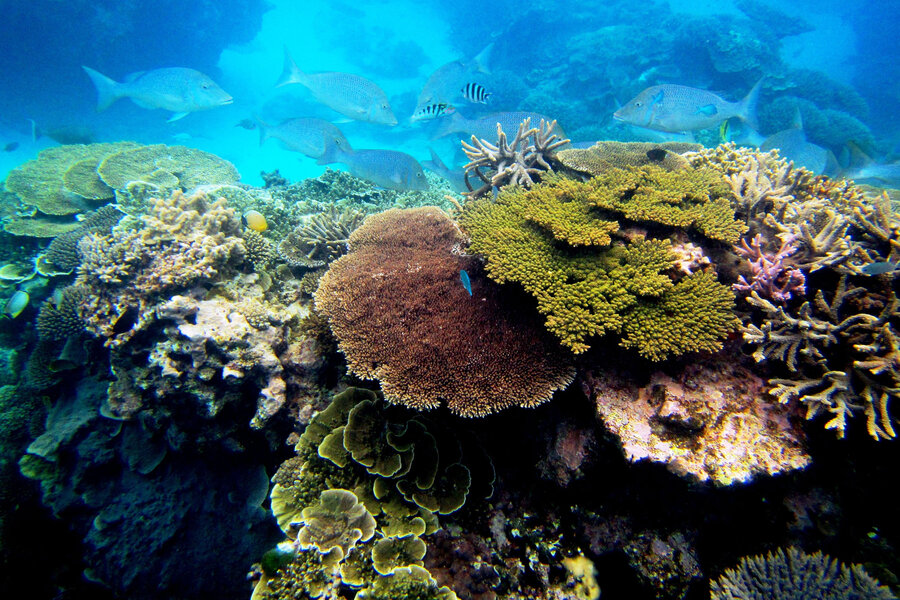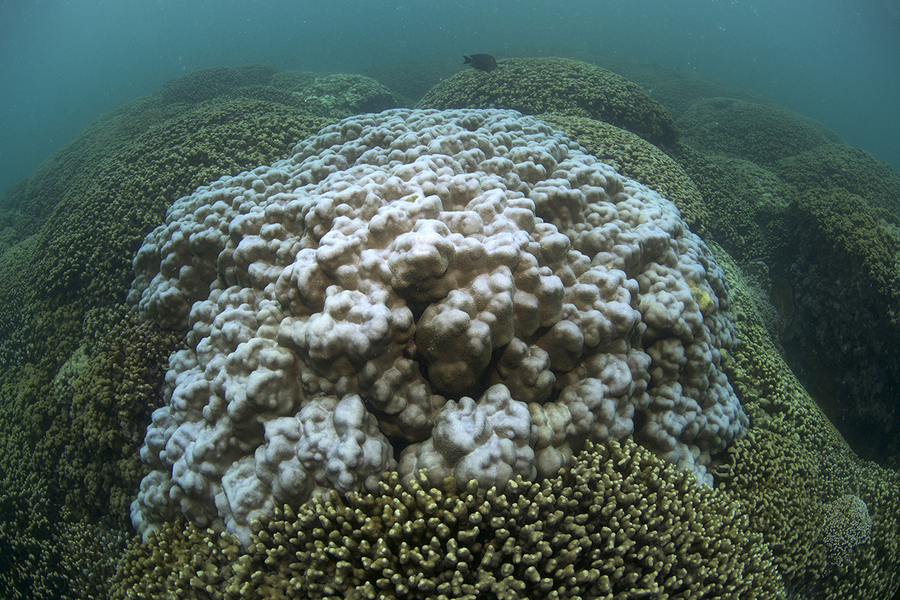From coral sperm banks to climate action: What's best to save reefs?
Loading...
| Kāneʻohe Bay, Hawaii
Conservation is often a race against the clock. But one scientist has taken it upon herself to find a way to freeze time – literally.
Armed with liquid nitrogen and freezers, marine biologist Mary Hagedorn of the Smithsonian Institution is fighting to save the spectacular diversity of the world’s coral reefs before too many of the thousands of coral species and other marine life that depend on them go extinct.
In the face of such a daunting endeavor, Dr. Hagedorn’s laboratory is small and nondescript. At a glance, it looks a bit like the average high school biology laboratory. But there, tucked among other marine biology offices on the 28-acre Coconut Island in Hawaii’s Kāneʻohe Bay, Hagedorn and colleagues are working on a science-fiction solution: cryopreservation.
Hagedorn and collaborators from around the world are developing techniques to build a reef sperm bank of sorts by freezing the reproductive cells of corals, algae, and even the fish that populate reef ecosystems. The idea is that such a resource would effectively preserve the genetic diversity of today’s reefs.
But Hagedorn’s chilly plan hasn’t received a warm reception by all conservationists.
While coral researchers generally agree that reefs are in peril and want to do all they can to save the spectacular marine ecosystems, they differ vastly on how best to do that. And that question largely comes down to the level at which humans should interfere and try to manage the ecosystem – a debate that extends to conservation beyond the reefs.
“It’s not a question of should we save reefs – they have to be [saved] – it’s a matter of how do we do that and how much of it can we save,” says Ohio State University marine scientist Andréa Grottoli.
A 'magical' sight
Coral reefs today are still largely vibrant ecosystems. Flashy fish, like the bright yellow forcepsfish, redlip parrotfish, spotted boxfish, and rainbow butterflyfish zip around reefs, stopping occasionally to nibble on the algae growing on the hard coral structures. Hagedorn calls it a “magical” sight.
But back-to-back mass bleaching events in recent years have ravaged many reefs, leaving the colorful marine structures dotted with white splotches and the coral polyps making up the foundation of the reefs fighting for their lives.
“There’s no sugarcoating it,” Professor Grottoli says. “It’s dire.”
At stake are not just species-rich ecosystems, but also an economic resource worth about $29.8 billion in tourism and fishing each year, according to the National Oceanic and Atmospheric Administration.
Hagedorn and Grottoli aren’t the only marine biologists who aren’t ready to give up on the reefs just yet. Many coral reef researchers are working doggedly to come up with ways to save the coral. But conservationists are divided as to whether it’s important to give each individual threatened species life-saving attention or focus on the overarching threats.
Cryopreservation, for example, could help scientists preserve the genetics of individual species so that it isn’t completely lost if the animal itself goes extinct in the wild. In Hagedorn’s vision, a bank of frozen coral gametes (sperm and eggs), or even embryos or coral fragments, would enable scientists to draw from that diversity for future endeavors – be it out-planting, hybridization, or just exploratory research.
'A sense of hope for the corals'
As a conservation option, Grottoli says, cryopreservation is not scalable. With ideas like cryogenic preservation and her own work identifying resiliency in corals, she says, “You can try to harness the genetic strengths of some species or populations and transplant them elsewhere as a way to mitigate reef loss. But those are all ideas that really can only be implemented on small, local scales.”
Small-scale restoration projects aren’t the best way to save coral reefs, opines Terry Hughes, director of the Australian Research Council’s Centre of Excellence for Coral Reef Studies. “We need to address the causes of the decline,” he says.
Although corals face local challenges, such as pollution and overfishing, warming ocean temperatures is largely thought to be triggering the large-scale bleaching events impacting coral reefs worldwide.
“There’s no point in putting corals that you’ve reared in a lab or frozen in a freezer back out on the reef if the reef is still a dangerous place to live,” Professor Hughes says.
Pollution and overfishing can be mitigated with local protections like marine parks, and replenished with small-scale projects, Grottoli says. But, she agrees with Hughes, “The only way that you can really preserve reefs on a global scale is by controlling climate change.”
That doesn’t mean scientists should rule out all other efforts to save the reefs, says David Vaughan, disagreeing with Hughes.
“All of the [current conservation efforts] put together really make a sense of hope for the corals,” he says.
Dr. Vaughan himself, as executive director of Mote Tropical Research Laboratory's Moore Center in Summerland Key, Fla., has been growing corals in his lab to out-plant in the Caribbean. He argues that, just as a doctor can treat a patient with a gunshot wound without advocating for lawlessness, coral reef scientists should be able to save species without condoning rampant anthropogenic climate change.
One aspect of the debate boils down to a broader question of whether coral reefs, or any threatened ecosystem, can still function without human intervention – a question that dogs conservationists outside of marine biology as well.
Some conservationists say that preserving an ecosystem and its precise biodiversity in the face of changing conditions is a futile effort, while others say the risk of losing too much biodiversity is too high.
“The challenge is to steer these changing ecosystems to a place where they’ll continue to be functional,” Hughes says. This, he suggests, may happen by natural selection if climate change is reined in, as the corals that survive bleaching will be more resilient and will evolve to fill the necessary ecological niches.
But if too much diversity in an ecosystem is lost, the ecosystem can collapse, Grottoli says.
With reefs being “one of the most important ecosystems in our ocean,” Hagedorn says, “my feeling is that you just do what you can.”
A breakthrough for cryo-corals
Still, developing cryopreservation techniques that work on reef species has proved tricky. So far, Hagedorn has successfully frozen coral sperm that, when thawed, is viable and can create new coral using fresh eggs. Hagedorn and colleagues have also figured out how to cryopreserve the algae that is symbiotic to the coral, and the sperm and embryos of sea urchins, which help maintain the balance of algae in a reef ecosystem.
Coral and other fish’s eggs and embryos proved more of a challenge to cryopreserve – until now. Hagedorn and colleagues in the engineering department at the University of Minnesota have now honed their technique to be able to cryopreserve zebrafish embryos, according to a paper published Thursday in the journal ACS Nano. And this same technique could work on coral embryos and eggs, Hagedorn says, as well as other fish and even frogs.
“It has taken me 14 years,” Hagedorn says. But “this technology will completely transform how we conserve wildlife,” she says, in confidence of her work.
As for the reefs, Hagedorn says, “Things are really bad, but there still is time.” And that’s why she hopes to train coral researchers out in the field to use her cryopreservation techniques so as many species’ genetics can be banked as possible.
Hagedorn brushes off criticism that such species-specific work is futile in the face of global threats to reefs. “These are just some of the tools that we are hoping to use to get us through this really hard time and also maintain the biodiversity for the future,” she says.










